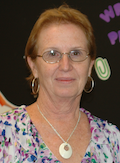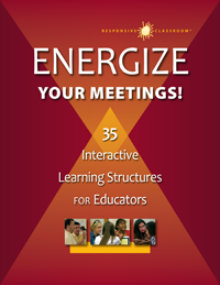A Bolt of High Energy for Your Dull Meetings
Energize Your Meetings! 35 Interactive Learning Structures for Educators
By Northeast Foundation for Children, 2014 – Learn more

Do your staff meetings and Professional Learning Communities need a bolt of lightning to energize the participants? Do you want your participants to enter willingly and leave reluctantly? Have you ever sat in a meeting and were afraid you might nod off?
Do you dread attending a staff meeting or professional development session? Walk out of meetings feeling that your time would have been spent much better some other way? Feel as if your voice isn’t heard because “the same colleagues” always dominate the discussion?
If you answered “yes” to any of the above questions, you are not alone.
What works in class can work in meetings

Professional development meetings should follow the same format as a “best practice” classroom. There should be active participation by members, a sense of belonging, a feeling of being respected, and a feeling that everyone’s input is valued and makes a difference.
Strategies to bring the best of classrooms to your meetings
Energize Your Meetings! 35 Interactive Learning Structures for Educators gives the term “effective meetings” a new look. This easy-to-implement Responsive Classroom guide provides 35 strategies for leaders to structure their meetings so that all attendees feel engaged and valuable.
Each activity follows a familiar structure: a brief summary of the strategy, easy-to-follow steps to initiate the protocol, sample scenarios, and ideas on how to vary each approach. This guidebook overflows with novel approaches and activities that are designed to have staff leaving with a sense of purpose and commitment.
This resource published by the Northeast Foundation for Children is like a breath of fresh air for teachers who dread attending meetings and for facilitators who are looking for new ideas to engage their colleagues.
An easy-to-follow table lists each structure with ideas for application, reducing the “chore” of trying to locate a learning structure that meets the needs of the meeting or workshop.
| Structure | Often Used For | Page |
| Roam, Read, Retrieve | Visiting locations around the school to gather information and generate ideas to address issues related to those areas | 50 |
| Say Something | Weighing in on a key stopping points when reading a text or viewing a video clip together | 52 |
| Scavenger Hunt | Learning key information in a resource by using an engaging checklist | 54 |
| Snowball | Sharing ideas in a fun way that builds team spirit | 56 |
One of the strengths of the book is the “Learning Structures in Action” sidebars, offering easy to apply examples to help facilitators visualize how each structure would work, taking the “guess out of guess work”. (See example below)
A learning structure in action
The district’s math teachers have previously seen and discussed school-wide data that indicate many students have high levels of competency in geometry but low levels of number sense. The math curriculum coordinator plans a meeting and decides to use the book’s Maitre d’ format to invite the math teachers to reflect on the data and begin to generate possible next steps.
He poses these questions to the group:
- Table for Three: “What shifts could you make in your whole-group instruction to boost students’ number sense?”
- Table for Four: “What types of small-group learning can be used to lift this skill?”
- Table for Two: “What do you need to know about individual learners to better address this skill with them?”
After these discussions, the math teachers come away with some new strategies for improving students’ number sense. (FYI, here’s an example of how the Maitre d’ format works with students. It might help you get the idea.)
As a facilitator, I can’t wait to apply these new strategies at my next workshop or team meeting. I firmly believe that these creative approaches to engage participants will help create a more collegial and professional culture within a school or learning community.
The joy of meeting
No longer will teachers be dragging their feet to attend meetings; instead, they’ll be rushing through the door, ready to be revitalized, renewed, and respected. The energy from the meetings will send sparks of electricity through the school. School leaders will be amazed at the collaboration, teamwork, and efficiency created.
If you are looking for an better-meetings book to purchase for your leadership team or your staff, put this collection of PD learning tools at the top of your list. Energize Your Meetings! 35 Interactive Learning Structures for Educators will never disappoint you, but will leave you and your colleagues asking for more.
Linda Biondi is a fourth grade teacher at Pond Road Middle School in Robbinsville, NJ, and a long-time Morning Meeting practitioner. She’s also the recipient of several educational grants, a Teacher Consultant with the National Writing Project and a participant on the NJ Department of Education Teacher Advisory Panel. She recently shared her thoughts about the Common Core at the NJ SDE website.

































